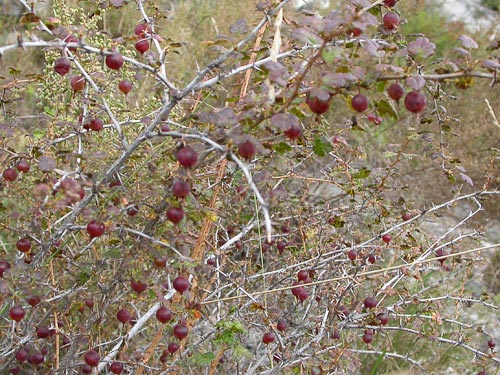Relatives
Grossularia acicularis (Smith) Spach - Needle-shaped gooseberry.
Taxonomic position.
Family Grossulariaceae Hill, genus Grossularia Mill.Morphology and biology.
Shrub up to 1.5 m high. Older offshoots are densely covered with thorns; bark is grey. Spines in the nodes are usually 3-5-partite, up to 1 cm long. Younger shoots are yellow-brown, yellow-grey or reddish. Leaves are rigid, 1-3 cm in diameter, more often bidentate, naked and glossy or slightly downy from both sides, rarely glandular from below. Petioles are shorter than or equal in length to the blade. Flowers are single, more rarely paired, set on naked or downy pedicels. The calyx is bell-shaped, naked or weakly pubescent; its lobes are naked from the outside, prostrate or bent downwards. Berries are yellowish, brown, red, black or smoke-blue, of globular shape, 10-15 mm in diameter, from naked to glandular-bristly, sour-sweet, savoury. Blossoms from the end of May; berries ripen from late July up to mid-September. Propagated by seed, layers or softwood cuttings. 2n = 12, 24.Distribution.
Altai-Sayan mountain region, Central Asia (Tarbagatai, Dzungarian Ala Tau, Tien Shan), China, Mongolia.Ecology.
Heliophilous. Typical xeropetrophyte. Usually grows on rocks, stony and rubbly placers, rocky mountainsides, in stony steppe and over rocky brook-banks. Occurs mainly within forest-steppe, forest and sub-alpine zones. In the mountains ascends to the upper verge of the forest.Utilization and economic value.
Used for food (berries). Nectariferous and medicinal plant. Interesting, first of all, as a source for breeding. Winter-hardy and drought-resistant, insusceptible to American mildew. Domesticated in 1930's. Participated in the breeding of winter-hardy gooseberry cultivars: Pervenets Minusinska, Muromets and others. Ornamental plant; recommended as such for single and group plantings, alpine garden-stands and afforestation of mountainsides.References:
Brezhnev, D.D., Korovina, O.N. Wild relatives of cultivated plants in the USSR flora. Leningrad: Kolos,1981. - P. 147.Flora of Siberia. Berberidaceae - Grossulariaceae. / Ed. L.I. Malyshev, G.A. Peshkova. - Novosibirsk: Nauka, 1994. - vol. 7, p. 208-209.
Koropachinskiy I.Yu., Vstovskaya T.N. Woody plants of the Asian part of Russia. - Novosibirsk: Publishing House of SB RAS, Branch "Geo", 2002. - p. 267-268.


